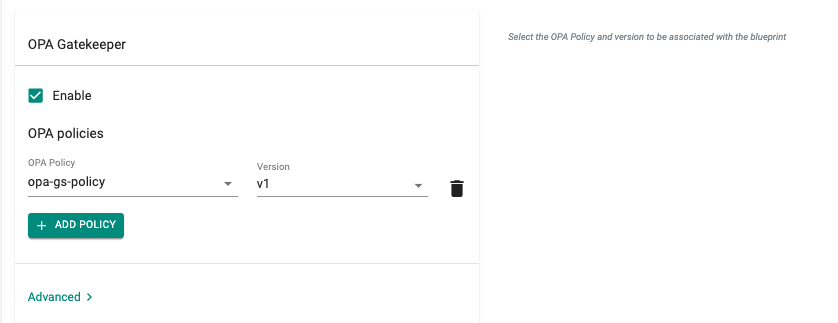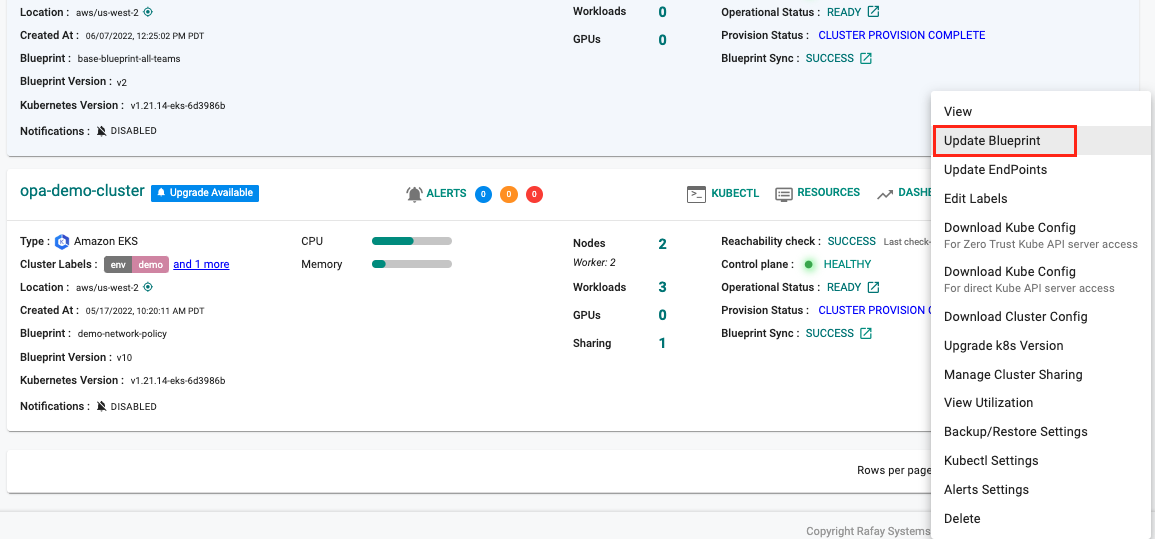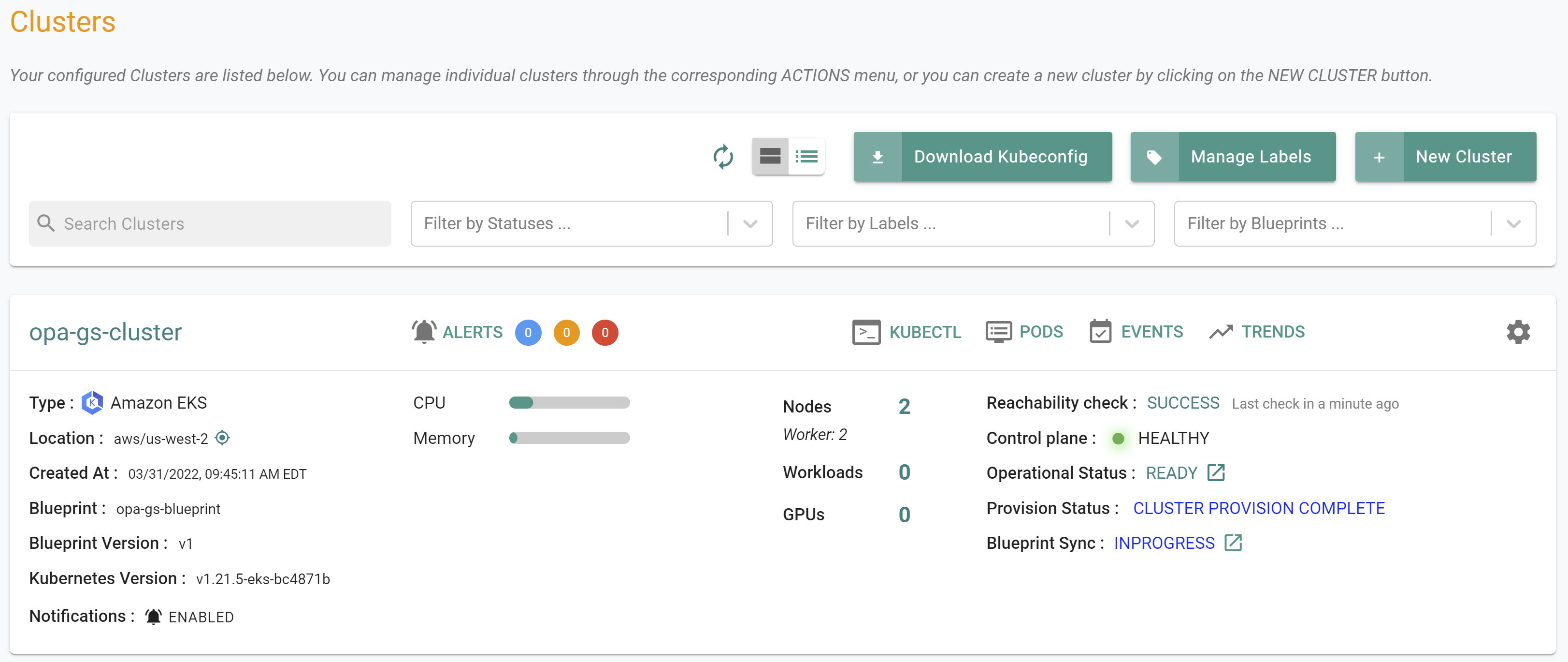Part 3: Blueprint
What Will You Do¶
In this part of the self-paced exercise, you will create a custom cluster blueprint with the previously created OPA Gatekeeper policy.
Step 4: Create Blueprint¶
In this step, you will create a custom cluster blueprint with OPA Gatekeeper.
- Under Infrastructure section, navigate to Blueprints
- Create a New Blueprint, provide a name (e.g. opa-gs-blueprint) and select Custom Blueprint as the type
- Provide a version name (e.g. v1)
- Navigate to the OPA Gatekeeper section and select Enable
- Click Add Policy and add the OPA Gatekeeper policy along with the version (opa-gs-policy, v1)
- Click Save Changes
Step 5: Update Cluster Blueprint¶
In this step, you will update the cluster to use the newly created custom blueprint with OPA Gatekeeper and the defined policy.
- Navigate to Infrastructure -> Clusters page
- Click on the gear icon next to the cluster
- Select Update Blueprint
- Select the blueprint and the version (e.g. opa-gs-blueprint, v1)
- Click Save and Publish
After the blueprint sync operation is complete, you should see the cluster is now using the "opa-gs-blueprint
- Navigate to Infrastructure -> Clusters
- Click on "KUBECTL" in the cluster card
- Type the command below
kubectl get pods -n rafay-system
Once the custom cluster blueprint is applied to the target cluster, all configured add-ons (managed and self managed) are automatically deployed to the cluster. You should see a result like the following showing the OPA Gatekeeper pods running.
NAME READY STATUS RESTARTS AGE
controller-manager-v3-6b748b7695-nnffs 1/1 Running 0 4m28s
edge-client-67b7695748-9qfll 1/1 Running 0 2m51s
gatekeeper-audit-7f574bdf8b-kkpz4 2/2 Running 0 104s
gatekeeper-controller-manager-867b454866-8g4mx 2/2 Running 0 104s
gatekeeper-controller-manager-867b454866-qd5zd 2/2 Running 0 104s
gatekeeper-controller-manager-867b454866-rjx2k 2/2 Running 0 104s
ingress-controller-v1-controller-bzhsb 1/1 Running 0 3m23s
ingress-controller-v1-controller-s6ckz 1/1 Running 0 4m4s
rafay-connector-v3-7f97cd668-wc9nj 1/1 Running 0 4m28s
relay-agent-5f99474d86-jkmz4 1/1 Running 0 4h8m
Recap¶
As of this step, you have created a cluster blueprint with OPA Gatekeeper and applied this blueprint to an existing cluster. You are now ready to move onto the next step where you will deploy a test workload to test the policy constraints.
Step 4: Create Blueprint¶
In this step, you will create a custom cluster blueprint with OPA Gatekeeper. The "blueprint-v2.yaml" file contains the declarative specification for the blueprint.
- Open Terminal (on macOS/Linux) or Command Prompt (Windows) and navigate to the folder where you forked the Git repository
- Navigate to the folder "
/getstarted/opa_gatekeeper/blueprint"
Important
Ensure you update the "project: defaultproject" with the name of the project in your Org
apiVersion: infra.k8smgmt.io/v3
kind: Blueprint
metadata:
name: opa-gs-blueprint
project: defaultproject
description: opa getting started blueprint
spec:
base:
name: default
version: 1.17.0
defaultAddons:
csiSecretStoreConfig:
providers: {}
enableIngress: true
enableLogging: false
enableMonitoring: true
enableVM: false
drift:
enabled: false
networkPolicy: {}
opaPolicy:
opaPolicy:
- name: opa-gs-policy
version: opa-gs-policy-version
profile:
name: default
placement: {}
sharing:
enabled: false
version: v1
- Type the command below to create the blueprint
rctl apply -f blueprint-v2.yaml
If you did not encounter any errors, you can optionally verify if everything was created correctly on the controller.
- Navigate to the "defaultproject" project in your Org
- Select Infrastructure -> Blueprint
- Click on the "opa-gs-blueprint" custom cluster blueprint
Step 5: Update Cluster Blueprint¶
In this step, you will update the cluster to use the newly created custom blueprint with OPA Gatekeeper and the defined policy.
- Replace the cluster name, "opa-gs-cluster", in the command below with the name of your cluster.
- Run the updated command
rctl update cluster opa-gs-cluster -b opa-gs-blueprint --blueprint-version v1
If you did not encounter any errors, you can optionally verify if everything was created correctly on the controller.
- Navigate to the "defaultproject" project in your Org
- Select Infrastructure -> Clusters
- You should see the cluster is now using the "opa-gs-blueprint
- Navigate to Infrastructure -> Clusters
- Click on "KUBECTL" in the cluster card
- Type the command below
kubectl get pods -n rafay-system
Once the custom cluster blueprint is applied to the target cluster, all configured add-ons (managed and self managed) are automatically deployed to the cluster. You should see a result like the following showing the OPA Gatekeeper pods running.
NAME READY STATUS RESTARTS AGE
controller-manager-v3-6b748b7695-nnffs 1/1 Running 0 4m28s
edge-client-67b7695748-9qfll 1/1 Running 0 2m51s
gatekeeper-audit-7f574bdf8b-kkpz4 2/2 Running 0 104s
gatekeeper-controller-manager-867b454866-8g4mx 2/2 Running 0 104s
gatekeeper-controller-manager-867b454866-qd5zd 2/2 Running 0 104s
gatekeeper-controller-manager-867b454866-rjx2k 2/2 Running 0 104s
ingress-controller-v1-controller-bzhsb 1/1 Running 0 3m23s
ingress-controller-v1-controller-s6ckz 1/1 Running 0 4m4s
rafay-connector-v3-7f97cd668-wc9nj 1/1 Running 0 4m28s
relay-agent-5f99474d86-jkmz4 1/1 Running 0 4h8m
Recap¶
As of this step, you have created a cluster blueprint with OPA Gatekeeper and applied this blueprint to an existing cluster. You are now ready to move onto the next step where you will deploy a test workload to test the policy constraints.



